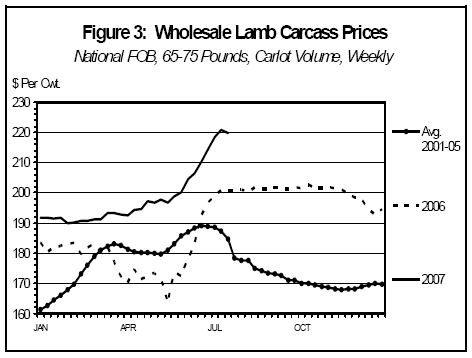AG-ECO NEWS
Vol. 23, Issue 20, July 31, 2007
Jose G. Peña
Extension Economist-Management
U.S. Mid-Year Sheep and Goat Inventory: Sheep Down Slightly; Goats Up 4 Percent
USDA’s mid-year Sheep and Goats report, released on July 20, 2007, indicated that while the U.S. sheep andlamb inventory dropped slightly from a year ago, the U.S.all-goat inventory increased about four percent. The U.S.sheep and lamb herd totaled 7.73 million head on July 1,2007, down 40,000 head (0.5%) from an inventory of 7.77million head on July 1, 2006, (See Figure 1). The U.S. allgoat inventory, increased 130,000 head (3.8%) to 3.595million head from an inventory of 3.465 million head a yearago (See Table 1).
| Table 1. Goats: Number by Class, United States, July 1, 2005-2007 |
||||
| 2005 | 2006 | 2007 | %CHG. | |
| Angora | 290,000 | 285,000 | 260,000 | -8.8% |
| Milk | 320,000 | 320,000 | 335,000 | 4.7% |
| Meat | 2,740,000 | 2,860,000 | 3,000,000 | 4.9% |
| All | 3,350,000 | 3,465,000 | 3,595,000 | 3.8% |
While the inventory of angora goats declined by25,000 head (8.8%), it is interesting to note that theinventory of milk goats increased by 15,000 head (4.7%)and the inventory of meat goats increased by 140,000 head (4.9%). It appears that meat goats are replacing sheep at aratio of 3.5 to one.
Prior to last year’s slight decline, the size of the sheep and lamb herd had increased for two years after elevenyears of steady declines. The size of the herd at7.73 million head remains above the inventory low of7.65 million on July 1, 2004. Last year, it appearedthat the size would stabilize at about 7.7-7.8 millionhead as the main commercial sheep product focusedon lamb production and became less dependent onwool production. This shift appeared supported by a shift to more hair sheep. It now appears that the residual effects of the ‘05-‘06 drought, the termination of ewe lambretention program, an increase in predatation control problems, high energy costs and the ‘06-‘07 softening of lambmarkets combined to influence individual decisions to continue to thin their sheep herds.
Lamb Market
The lamb market had been showing improvement since mid-2002 with prices reaching record highs in 2005 asthe total U.S. sheep and lamb inventory continued to decline. Feeder lamb prices at San Angelo remained fairly strongthroughout 2005. While market prices remain relatively attractive, prices have weakened from 2005’s record highs (SeeFigure 2). While wholesale lamb carcass prices have shown a significant improvement this summer (see figure 3), pricebids for feeders have remained below 2005’s record highs. The market for feeder lambs is expected to improve as feederlamb supplies remain relatively tight.


The 2007 lamb crop is expected to total 4.12 million head up about 30,000 head (0.73%) from a lamb crop of 4.09million head in 2006, with 88.3 percent of the lambs born prior to July 1, 2007. An additional 480,000 lambs are expectedto be born during July through December 2007. Tight supplies of lambs, appears to indicate that the market will remainrelatively strong, despite the recent weakness. Keep in mind that while feeder lamb prices have declined from 2005’srecord highs, prices remain significantly above the 2000-04 average.
Breeding Herd Down
The breeding sheep inventory on July 1, 2007 at 4.61 million head was down 0.5 percent from July 1, 2006. Thebreeding herd consisted of 3.76 million ewes one year old and older, 185,000 rams one year old and older, and 665,000 replacement lambs (including newborn lambs). (See Table 2). The inventory of market sheep and lambs (includingnewborn lambs) at 3.12 million head, was down 0.5 percent. The inventory of market lambs at 3.055 million headremained the same as last year, consisting of 1.81 million lambs under 65 pounds, 650,000 lambs 65-84 pounds, 360,000lambs 85-105 pounds and 250,000 lambs over 105 pounds. The market sheep inventory was 65,000 head.
| Table 2. U.S. Sheep, Lamb, Breeding Sheep and Lamb Inventories – July 1, 2006-2007 | ||||||
| All Sheep and Lamb Inventory (1,000 head) | ||||||
| 2006 | 2007 | ’07 as % of ’06 |
||||
| All Sheep & Lambs | 7,770 | 7,730 | -0.5% | |||
| Breeding Sheep & Lambs | 4,635 | 4,610 | -0.5% | |||
| Market Sheep & Lambs | 3,135 | 3,120 | -0.5% | |||
| Market Lambs | 3,055 | ,3055 | 0.0% | |||
| Ewes | 3,780 | 3,760 | -0.5% | |||
| Rams | 185 | 185 | 0.0% | |||
| Replacement Lambs | 670 | 665 | -0.7% | |||
| Total Breeding Sheep & Lambs 1995-2007: | ||||||
| 2002 | 2003 | 2004 | 2005 | 2006 | 2007 | ’07 as % of ’06 |
| 4,780 | 4,610 | 4,545 | 4,655 | 670 | 665 | -0.5% |
| 1995 | 1996 | 1997 | 1998 | 1999 | 2000 | 2001 |
| 6,450 | 6,170 | 5,775 | 5,575 | 5,350 | 5,030 | 4,900 |
